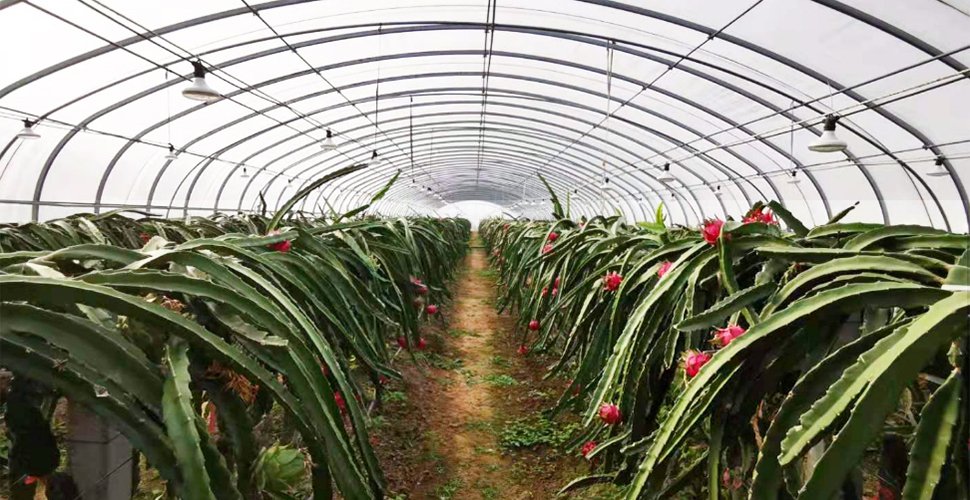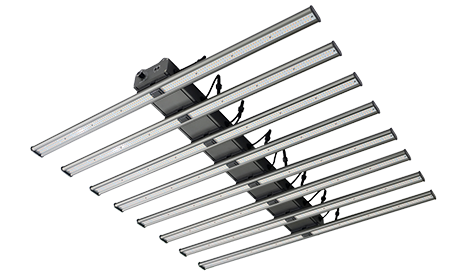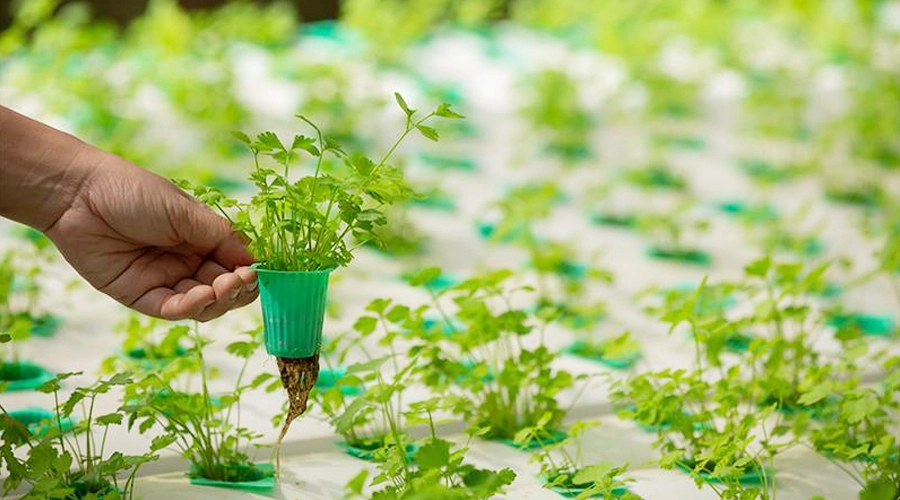Efnisyfirlit
Several vegetable farmers are now starting to grow fruits through the advantage of greenhouses. Even vegetable farmers who are in the north will turn to growing dragon fruit indoors.
Planting in the northern region must need to build greenhouses, and need supporting equipment LED plant lights. Is it costly to build initially and is it profitable?
Some growers have also asked how to grow dragon fruit in islands. Well, that is possible, provided it depends on your area and whether you are growing outdoors or indoors. But greenhouse growth is the most conservative way to grow.
As a greenhouse grower, remember that with any investment comes risk. Growing dragon fruit indoors is indeed a great market prospect, but you also need to decide your direction of planting according to the local market.
Your ultimate goal is to realize profit by growing. You need to understand the local consumer demand for the fruit, whether people like dragon fruit and how much dragon fruit is sold in the local hypermarket or grocery store.
Let’s take a look at the following two vegetable farmers who have benefited from growing dragon fruit in greenhouses. Even if you are a home grower, you can learn from the article and apply it to grow dragon fruit in a pot, grow dragon fruit from cuttings or your dragon fruit cactus houseplant.
The Story of Dragon Fruit and Greenhouse Growers
Ms. Guo with the Dragon Fruit
Speaking of fate with dragon fruit, Ms. Guo, who has operated a vegetable greenhouse for 12 years, was happy to talk to us about her first meeting with dragon fruit.
In 2020, an opportunity to go on a study tour, she noticed the good economic benefits, long hanging time, good management, and easy-to-sell dragon fruit.
When seeing pitaya at the first glance, a dragon fruit seed was buried in her heart. Because of no planting experience and fear of investment failure, she failed to take any action.
But seeing the dragon fruit market in short supply, the period benefits are becoming increasingly considerable. In 2020, an experimental path was laid out in her greenhouse.
Ms. Guo went around looking for ways to grow dragon fruit indoors successfully, from the internet to books and from south to north. After caring and nurturing, she harvested her first dragon fruit in 2021. At the same time, she has accumulated a lot of experience in cultivation.
Ms. Guo said, “dragon fruit planting compared to vegetables to save labor, fewer pests, and diseases, almost year-round results. The dragon fruit picking period is relatively long. Starting from March, the picking period can last until the end of November.”
“Now on my farm, the annual production of dragon fruit can produce about 7,000 to 9,000 pounds per acre. At RMB 12 a pound, each acre can generate about 80,000 yuan.” She told us happily.
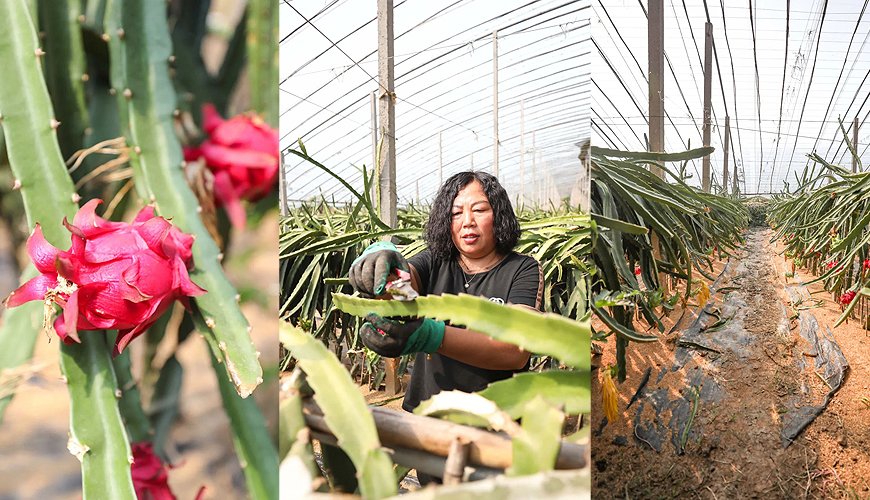
Ms. Guo with the Dragon Fruit
Mr. Hu, who is in his 50s this year, is also a member of the greenhouse growing dragon fruit. In his greenhouse is a tropical fruit that is rarely grown in northern China.
Mr. Hu started to grow greenhouse vegetables in 2004. By chance, a friend gave him a pot of dragon fruit, which unexpectedly produced a lot of fruit. This gave Hu the idea of growing dragon fruit in greenhouses.
Mr. Hu shared with us that in the past, the greenhouse dragon fruit reached the end of the crop in October. The greenhouse can guarantee the normal growth temperature of dragon fruit, but after October, the light time is significantly shortened.
At the end of 2021, he added the LED dragon fruit lighting system to the greenhouse. The result was unexpected, with three more crops of fruit than in previous years, achieving uninterrupted dragon fruit cactus fruit all year round.
To add diversity and varietal character, Mr. Hu planted additional yellow dragon fruit and bicolor pitaya in 2022, ripening in early 2023. Approximately 15,000 red dragon fruit trees are planted in two greenhouses.
At this time in March, the temperature in northern China is still low, and only one fruit is left on a plant. We need to wait until the summer when the temperature is high, a plant can leave three or four fruits.
Dragon fruit ripe also does not need to rush to pick, it is different from vegetables. Because the dragon fruit branches hang longer and require less work, which is what Hu now values most.
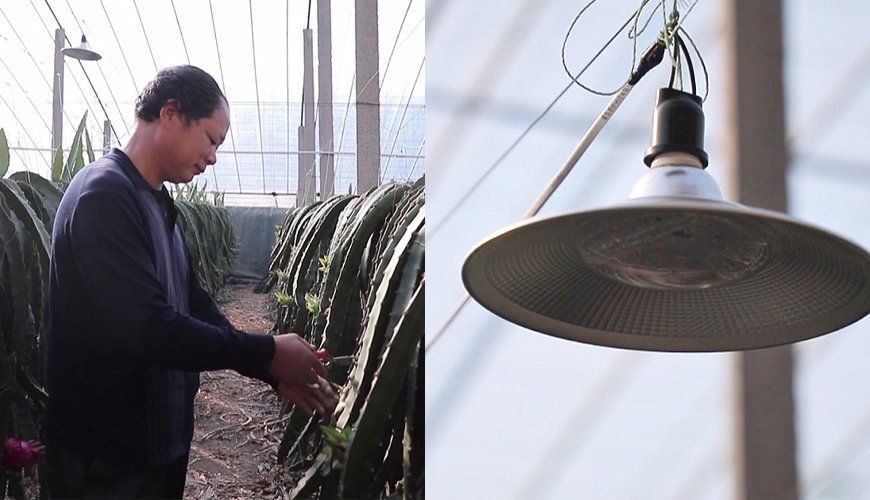
Stutt yfirlit
The use of LED grow lights in the greenhouse has given confidence to these two experienced growers.
If you don’t know enough about LED grow lights, you can simply read an article shared in AUXGROW to see if full spectrum grow lights are worth it.
For those of you who are thinking of investing in dragon fruit growing, does it add to your confidence? Then why not check out the shared experiences of successful people growing dragon fruit in greenhouses?
Thinking about investing in dragon fruit farming, have you gained confidence? Let’s take a look at the shared experience of successful people growing pitaya in the greenhouse.
Which Month is Best for Growing Dragon Fruit?
- Dragon fruit can be grown almost all year round in the warm southern regions, but in the northern regions, it is best to avoid winter planting.
Dragon fruit planting is based on cuttings. If the root system is not cultivated well in advance before planting in winter, there are difficulties in wintering.
Spring, summer, and autumn can be planted, especially spring and autumn are more suitable for dragon fruit planting.
- Planting 30cm seedlings around mid-March, a small amount of fruit can be produced with good management. Planting 60cm seedlings will produce more fruits.
- Planting 60cm seedlings, the initial management cost is lower than the 30cm labor cost. And the cost recovery is faster.
- Planting each spring depends on the weather conditions of the region, usually from March to April. High-temperature can be planted earlier and low-temperature can be delayed.
- Planting dragon fruit in the fall is also very good, plant this fall and have a good harvest next year!
What are the Methods of Growing Dragon Fruit?
We just mentioned that dragon fruit growing is based on cuttings. Next, we look at the method of growing dragon fruit in greenhouses.
Dragon Fruit Cuttings
In spring, the cuttings are selected from the full-grown stem nodes and cut into small sections 15cm in length.
Wait for the cuttings to air-dry and insert them into the sand bed, about 15-30 days to root.
Dragon fruit roots grow to 3~4cm when transplanted to the seedbed.
Dragon Fruit Grafting Seedlings
Select the rootstock with no pests or diseases, strong growth and full flesh of the stem to be grafted on a sunny day.
Cut the dragon fruit stem with a knife plane, insert the scion, align the forming layer, and fix it with cotton thread ties.
Under the condition of 28-30℃, the cut will have a large amount of healing tissue formation on the joint surface in 4-5 days. The color of the scion and rootstock are close, indicating that the healing.
Grafting success, the latter can be moved into the pseudo-planting seedbed to continue to cultivate.
Dragon Fruit Seedling Management
It is advisable to choose a field with ventilation and sunlight, fertile soil and convenient drainage and irrigation for seedling beds. Make a fine border with a 90cm ditch.
Fertilize 667 square meters with 1500~2000kg of chicken manure or cow manure, mixed with 1000kg of grain hull ash, stir well, and apply to the topsoil layer 10~20cm below the border surface when preparing the land.
After that, 100-150kg of calcium and magnesium phosphate fertilizer was applied in the topsoil layer 4~5cm deep after mixing thoroughly.
Then plant the seedlings 3cm apart in the seedbed, water them, and spray 500 times carbendazim once.
Apply 5~7kg of compound fertilizer every 10-15 days, and wait for the first stem section with full flesh to grow out of the bed.
How to Brace Red Dragon Fruit
Dragon fruit has a sprawling nature and must be planted with supports to facilitate growth, flowering, and harvesting management.
According to the fruit farmers’ practice sharing, there are three kinds of brackets available for greenhouse-growing red dragon fruit: freestanding brackets of reinforced concrete columns, rectangular row brackets of galvanized iron pipes, and crossed steel group brackets.
For home growing, red heart dragon fruit can also climb on low walls, and live stumps. However, it should not be cultivated on a trellis because the stems and vines that stretch horizontally, with many branches and few buds and flowers, rarely obtain ripe fruits.

What Environment Does Dragon Fruit Need to Grow?
Consumers like to choose the large sizes and good taste. It is a challenge for fruit farmers, with what to make consumers recognize your fruit? Only with scientific planting and management techniques.
Next, I will analyze in detail dragon fruit’s high quality and high-yield cultivation technology, I hope to engage in or be interested in planting dragon fruit farmers to provide a technical reference.
How Much Light Does Dragon Fruit Need?
Dragon fruit is not high on soil requirements, but the dragon fruit lighting requirements are very high.
If the light intensity in the planting area is insufficient, then the growth and development of dragon fruit will be seriously affected, such as small fruit and insufficient sweetness.
We ourselves are not willing to eat this type of fruit, do you think consumers are willing to pay for it?
Therefore, fruit farmers must ensure that the plant has the right light conditions for dragon fruit growth, which is also the most basic condition.
Those who have seen the dragon fruit plantation will notice that at night, the dragon fruit plantation site will be lit up with a whole sea of regular and orderly lights. Why are growers willing to spend more money on electricity to light up?
Dragon fruit is light and shade tolerant and needs a lot of light throughout the growing season to bloom and bear fruit. Cloudy and hazy days can make the dragon fruit cactus photosynthesis limited.
The LED grow lights for fruiting plants can ensure the normal growth of dragon fruit, together with the correct use and management, can make dragon fruit increase yield, prolong fruiting, and improve enhance taste and quality.
LED grow light for dragon fruit is suitable for growing indoors and outdoors. It is made on the basis that plants use sunlight for photosynthesis. The spectrum and power of the fill light are made according to the absorption and utilization of sunlight by plants.

It is useful not only for the growth of dragon fruit, but also for the nursery and growth of vegetables, fruits and flowers, and it is suitable in any planting place.
Mr. Hu mentioned above, also benefited from the addition of the LED dragon fruit lighting system in his greenhouse for supplemental lighting. 2022 saw three more crops of fruit produced in his greenhouse than in 2021.
According to a fruit farmer in Jiangmen, Guangdong, after installing LED supplemental lights, dragon fruit yield per mu rose from 4,500 kg to 6,000 kg. A year’s harvest increased from four to six, and the annual production doubled.
AUXGROW actively innovates and customizes the production of lighting specifically for different kinds of plants.
AUXGROW has produced a dragon fruit grow light for dragon fruit in the production process, such as flower thinning without fruit, no fruit in the opposite season, slow growth and insufficient light.
Temperature Requirements of Pitaya
The temperature suitable for the growth and development of dragon fruit is between 25℃ and 35℃. If the temperature is too high or too low, the dragon fruit will show abnormalities, the most common one is to stop growing.
Northern winter outside environment ambient temperature is basically below 0 ℃, but this does not mean that the north cannot plant dragon fruit. The north can also use sunroom planting, when necessary, through artificial heating to meet the dragon fruit growth temperature needs.
How to Care for A Dragon Fruit Cactus?
Dragon fruit starts to flower and bear fruit 12-14 months after planting. It can bloom 12-15 times a year.
The fruit is mature 30-40 days after flowering and weighs 500-1000g per fruit.
It produces more than 20 fruits per column in the second year after planting and enters the fruiting stage in the third year.
If the management level of a greenhouse is high, the yield can reach 2500kg/667㎡. Its high-yielding cultivation points are as follows:
Fertilization
The dragon fruit has a long harvesting period. Organic fertilizers, nitrogen, phosphorus and potassium compound fertilizers should be applied heavily every year, and in a balanced and long-term manner.
Top Trimming
Top trimming is performed when the branches grow to 1.3 to 1.4m long to promote branching and allow the branches to droop naturally.
This process involves removing the apical meristem, also known as the crown or tip of the plant, which controls the plant’s vertical growth.
Intercropping and Hand Pollination
When planting dragon fruit, interplant about 10% of the white flesh type of dragon fruit. This is because cross-pollination between varieties can significantly increase the fruit set rate.
In case of rainy weather, hand pollination should be carried out. Pollination can be done in the evening before the dragon fruit cactus flower open or early in the morning before the flowers close, using a brush to apply pollen directly to the female flower stigma.
Pruning and Shaping
Pruning and shaping are rather important tasks.
- If there are diseased branches on the plant, we need to prune them off to prevent the further spread of the disease.
- Cutting off some weak branches on the plant will not only reduce the plant’s nutrient consumption but also improve the plant’s ventilation and light conditions.
The fruit harvesting period of dragon fruit can reach about 10 years. There is no slack after the fruit picking is finished. To avoid excessive consumption of plant nutrients and to facilitate subsequent work, we also have to prune the plant once.
Pest and Disease Control
Although dragon fruit diseases and insects are relatively few, they are not non-existent in dragon fruit growing stages.
- Seedlings are susceptible to snails and ants, which can be controlled with insecticides.
- In the season of high temperature and high humidity, it is easy to be infected with diseases, and some parts of the branches appear necrosis and moldy spots, which can be controlled by powder rusting and strong copper oxide.
- In the fruiting period, put the fruit into special plastic bags, which can effectively avoid the damage of pests and birds to dragon fruit. When dragon fruit pests and diseases occur, fruit farmers need to spray to control them. Then in the case of bagging, you can reduce the pesticide residue.
Harvesting and Storage
How long to grow dragon fruit? The dragon fruit life cycle is about 30 days from flowering to fruit ripening. The fruits can be harvested when they gradually change from green to red and when they are slightly fragrant and bright.
Probably most farmers think that harvesting is the easiest part, just pick it off. However, the simpler the session, the more people don’t take it to heart.
We can’t just harvest the fruit at the moment, we have to consider many factors. Good or bad harvesting will directly affect the final yield of dragon fruit and transportation.
There are also tips for picking the fruit, such as picking from the stalk part of the fruit and trying to leave some stem flesh on the fruit so that the picked fruit can be stored for a longer period of time. Even after a few days of transportation, the fruit is still fresh.
Niðurstaða
Adding a dragon fruit lighting system in the greenhouse to realize “let the southern dragon fruit love the northern land”.
It is not difficult to grow high-quality and high-yielding dragon fruit, as long as you are serious and down-to-earth to do every detail of the work, you can grow good-tasting and good-selling dragon fruit.
Hvenær að velja LED vaxtarljós, fruit farmers also need to learn more about grow lights and guides to use greenhouse lighting fixtures to avoid unnecessary losses caused by wrong lamps and lanterns.
Hoping this article has provided an effective reference for you who are engaged in or interested in growing dragon fruit.
Jayes
Sem stafrænn markaðsstjóri hjá AUXGROW sameinar Jayes ástríðu fyrir vatnsræktunarkerfum og sérfræðiþekkingu í LED vaxtarljósum. Með praktískri reynslu og djúpum skilningi leiðir Jayes þig í gegnum heim sjálfbærrar ræktunar.

